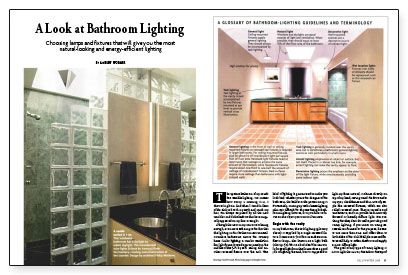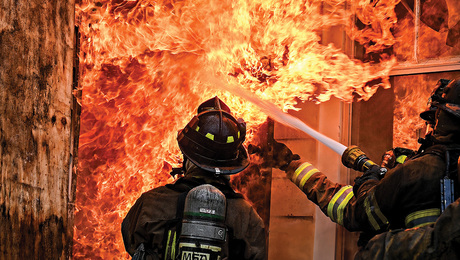A Look at Bathroom Lighting
Choosing lamps and fixtures that will give you the most natural-looking and energy-efficient lighting.

Synopsis: Bathrooms present unique lighting challenges. This article discusses considerations for choosing lighting fixtures and bulbs and suggestions where lights should be placed for the maximum benefit. It includes a glossary of terms that will make it easier to choose lighting fixtures plus a list of Internet sources of supply for those who like to shop online.
The upstairs bathroom of my condo has terrible lighting. No matter how sunny a morning it is, I shower in gloom. And when I stand in front of the sink to brush my teeth and comb my hair, I’m always surprised by all the new wrinkles and dark shadows that have magically appeared on my face overnight.
Although the view in my mirror is sobering enough, even more sobering is the fact that the lighting in this bathroom isn’t unusual. Countless bathrooms across the country have similar lighting: a combo ventilation fan/light fixture located approximately in the middle of the 5-ft. by 8-ft. ceiling and another recessed fixture over the sink. This kind of lighting is guaranteed to make you look bad, whether you’re the designer of the bathroom, the builder or the person using it. Fortunately, coming up with a better lighting plan isn’t difficult. To choose the right bathroom-lighting fixtures, first you have to focus on the object you want to illuminate.
Begin with the vanity
In my bathroom, the task lighting is supplied by a single recessed fixture. It contains a 50w R20 incandescent reflector lamp — also known as a light bulb. This is a bad idea. The narrowly focused light from this fixture does a good job of lighting the sink, but it’s supposed to light my face. Instead, it shines directly on top of my head, casting weird shadows under my eyes, cheekbones and chin. Lots of people like recessed fixtures, which are also called recessed cans. They’re versatile and unobtrusive, and can provide both narrowly focused or broadly diffuse light. But one thing that they don’t do well is provide good vanity lighting. If you insist on using recessed-can fixtures for this purpose, be sure to use more than one, and offset them to both sides of the sink. Multiple recessed fixtures will help to soften shadows and supply a more diffuse light.
The goal of any type of vanity lighting is not to light the mirror, the sink or the top of the head, but to light the face. Therefore, the best vanity task lighting is supplied by wall-mounted fixtures at eye level on both sides of the mirror. When these types of fixtures have multiple lamps that are arranged vertically, they produce desirable, virtually shadowless lighting that is called vertical cross illumination.
Many different types of fixtures produce this type of lighting. For example, most folks are familiar with so called “Hollywood lights,” or metal strips with multiple incandescent globe lamps. My downstairs bathroom has a single Hollywood light mounted above the mirror, and the light quality is much better than in the upstairs bath. This simple theatrical design has mutated into many different consumer-oriented incarnations, but the original idea was to surround a mirror with light that would shine evenly onto the face. Of course, most residential bathrooms forget about the lights on the side and simply mount a single light strip above the mirror. This option produces mirror lighting better than that of most ceiling-mounted fixtures but still not as good as fixtures mounted to the sides of the mirror.
For more photos and details, click the View PDF button below:
Fine Homebuilding Recommended Products
Fine Homebuilding receives a commission for items purchased through links on this site, including Amazon Associates and other affiliate advertising programs.

A Field Guide to American Houses

Graphic Guide to Frame Construction

The New Carbon Architecture: Building to Cool the Climate


























